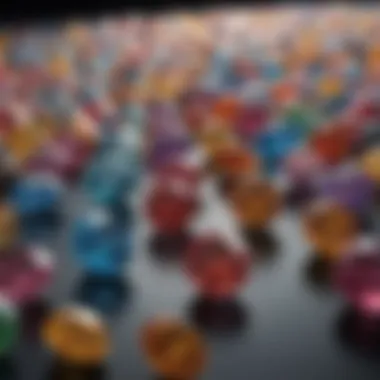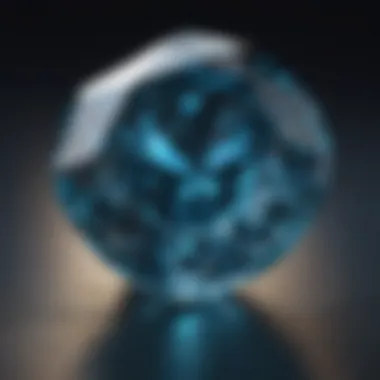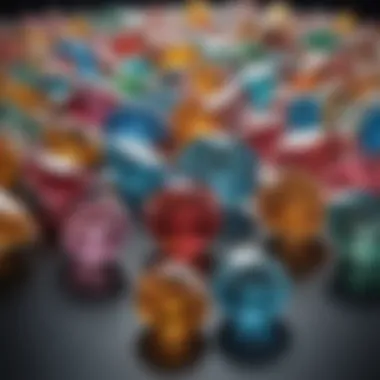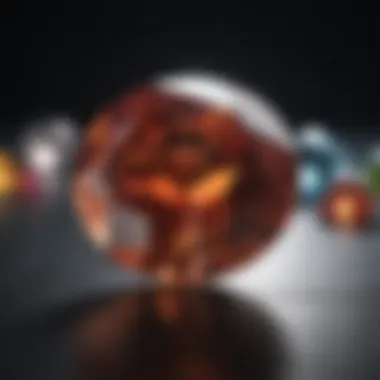Best Color Diamonds to Buy: A Comprehensive Guide


Intro
Color diamonds have become increasingly popular in recent years, captivating enthusiasts and investors alike. Understanding these gems requires more than just knowing their aesthetic appeal. Their value is influenced by various factors, including hue, saturation, and market trends. In this guide, we will delve into the nuances of color diamonds, offering insights that can aid collectors and buyers in making informed decisions.
Gemstone Overview
Definition and Characteristics
Color diamonds, unlike traditional white diamonds, exhibit a range of colors that can be quite striking. The colors can range from yellow to blue, pink to green, and even shades that might not be immediately identifiable. The unique properties of these diamonds contribute to their high demand. Key characteristics include the diamond's hue, tone, and saturation:
- Hue refers to the actual color of the diamond, such as pink or green.
- Tone describes how light or dark the color is, affecting its overall appearance.
- Saturation indicates the intensity of the color. A more vivid color generally holds higher value.
These elements interplay to create the gemstone's overall appearance and marketplace appeal.
Classification of Gemstones
Gemstones are typically classified based on their physical and optical properties. Color diamonds fit into categories depending on their specific hues. For instance:
- Fancy Color Diamonds: These diamonds are graded on a scale of color intensity, which can further influence their market value.
- Natural vs. Treated Diamonds: Natural diamonds occur without intervention, while treated diamonds undergo processes to enhance their color. Natural stones are usually more valuable.
- Rarity: Some colors are found only in very limited quantities. For example, red and blue diamonds are among the rarest and highly sought after by collectors.
Understanding the classification system of gemstones is essential for potential buyers. It helps in recognizing value and rarity within the market.
Historical Significance
Ancient Uses and Cultural Importance
Throughout history, gemstones have held significant importance across cultures. Color diamonds are no exception. They were coveted by royalty and were often seen as symbols of power and prosperity. In ancient civilizations, these stones were believed to possess mystical properties, providing protection and enhancing power.
Myths and Legends Surrounding Gemstones
Various myths surround color diamonds. For instance, in some cultures, it is thought that diamonds bring luck and prosperity to their owners. The allure of color diamonds can also be attributed to their associations with certain traits or characteristics in different societies. These narratives enrich the cultural fabric surrounding these remarkable gemstones, making them even more appealing to collectors and investors.
"Understanding the historical context of color diamonds can enhance their value and significance to collectors."
In examining color diamonds, we not only appreciate their physical beauty but also their rich history and cultural relevance. This comprehensive understanding assists in making informed decisions when considering such investments in unique gemstones.
Preamble to Color Diamonds
Color diamonds have captured the interest of collectors, investors, and casual enthusiasts alike. Their unique hues and brilliant appearances set them apart from traditional white diamonds. This section aims to lay the groundwork for understanding the fascinating world of color diamonds. By delving into this topic, readers can better appreciate the significance of these gemstones. The appeal of color diamonds lies not only in their aesthetic value but also in their investment potential.
Understanding Color Diamonds
Color diamonds are diamonds that exhibit hues beyond the standard white or near-colorless. They can range from shades like pink, blue, and yellow to more unique tones like green and orange. The grading of color diamonds is based on three main factors: hue, tone, and saturation.
- Hue represents the basic color of the diamond. For instance, a pink diamond has red and blue hues called purples, while blue diamonds lean towards the blue segment of the color spectrum.
- Tone pertains to the lightness or darkness of the hue, which can be light, medium, or dark.
- Saturation evaluates the intensity of the color. Highly saturated diamonds appear vivid and vibrant, while less saturated variants seem more pastel.
Understanding these principles is essential for anyone looking to purchase or invest in color diamonds. Recognizing the distinctions helps in assessing quality and value.
The Importance of Color in Diamonds
Color plays a pivotal role in determining the desirability of a diamond. Unlike traditional diamonds, where the absence of color signifies value, color diamonds thrive on their vibrant shades and unique characteristics. The market values certain colors more than others due to their rarity.
"The market for color diamonds is driven by rarity and desirability. The more scarce the color, the higher its potential value."


Many buyers seek out specific colors based on personal taste or investment criteria. It's crucial for buyers to understand how color impacts a diamond's price and appreciation potential. Factors like market trends also influence color preferences over time.
Categories of Color Diamonds
Understanding the various categories of color diamonds is crucial for both enthusiasts and investors. The classification helps buyers identify specific features that may influence their choice. Each category carries unique attributes, value implications, and aesthetic appeal. Grasping these differences can enhance purchasing decisions and longevity of enjoyment or investment potential.
Natural Color Diamonds vs. Treated Color Diamonds
Natural color diamonds are gems that have formed through geological processes without human intervention. Their colors are a result of specific environmental factors and inherent characteristics. Conversely, treated color diamonds have undergone processes to enhance or change their appearance. Treatments could include high-temperature annealing or color enhancement techniques.
Natural diamonds tend to hold more value because of their rarity. Treated diamonds, while often visually stunning, generally carry lower prices. Buyers should consider the implications of these differences carefully, as purchasing a diamond should align with personal or investment goals.
Types of Color Diamonds
When one thinks of color diamonds, several distinct types come to mind, each with specific qualities and characteristics.
Pink Diamonds
Pink diamonds are particularly prized for their rarity and beauty. The key characteristic of pink diamonds lies in their unique hues ranging from light, delicate shades to intensely vibrant tones. Investors often favor them because their values have seen significant appreciation over the years.
Pink diamonds' unique feature is their origin; the color comes from a complex structure that alters light absorption. Although they can be expensive, their growing popularity often makes them a beneficial choice for buyers looking at long-term investment.
Blue Diamonds
Blue diamonds are among the most sought-after gemstones due to their stunning appearance. Their color comes from the presence of boron during formation. The alluring hue can range from a light, subtle blue to an intensely deep shade. This natural beauty often attracts collectors, ensuring their high desirability.
A notable advantage is their historical appreciation in value, making them a popular option for investors. However, their rarity can also lead to significantly higher prices which some may find prohibitive.
Yellow Diamonds
Yellow diamonds, or canary diamonds, are well known for their bright, cheerful color that stems from nitrogen impurities. The key characteristics of these diamonds range from light yellow to deep golden tones. They are often more affordable compared to other color diamonds, which can make them a beneficial choice for buyers just starting to collect.
Their unique feature lies in their versatility; they complement various styles and settings well. Despite their relatively lower price point, some buyers may regard them as less prestigious compared to rarer colors.
Brown Diamonds
Brown diamonds, also called champagne or chocolate diamonds, are famous for their warm, earthy tones. Their color results from the distortion of the diamond's crystal lattice. They are often more abundant than other colors, making them a popular choice for those seeking an affordable option.
One advantage of brown diamonds is their growing trend within the jewelry market, appealing to modern tastes. However, they may face challenges in terms of perceived value compared to more vibrant color diamonds.
Green Diamonds
Green diamonds are unique in that their color often results from natural irradiation over time. Their shades can range from a delicate mint to deep emerald. Because of this method of coloration, they can be more unpredictable in pricing and value retention.
The unique feature of green diamonds is their rarity and the peculiar yet beautiful shades they can display. They can hold significant value, but buyers must carefully assess their distinct attributes before making a purchase.
Orange Diamonds
Orange diamonds are a striking choice for those looking to invest in vibrant gems. Their coloration results from a specific crystal structure. They can present a vivid, fiery appearance, attracting buyers who appreciate bold aesthetics.
A notable advantage of orange diamonds is that they are relatively rare yet still remain affordable compared to other highly sought colors. Their unique feature is the captivating hue they present, though their market presence is not as strong as that of other colors, impacting their long-term investment outlook.
Color diamonds offer a wide range of hues and choices, making them appealing to both collectors and investors. Understanding their unique characteristics can lead to making informed choices.


Factors Influencing Value
Understanding the factors that influence the value of color diamonds is crucial for potential buyers. It can guide decisions when selecting gems that not only resonate aesthetically but also hold financial promise. Color diamonds are not all created equal. Several intrinsic and extrinsic elements govern their market valuation. This section explores these elements, emphasizing the significance of hue, tone, saturation, rarity, and certification in the overall assessment of color diamonds.
The Role of Hue, Tone, and Saturation
When evaluating color diamonds, three critical factors come into play: hue, tone, and saturation.
Hue refers to the actual color of the diamond, such as its classification as blue, pink, or yellow. Each hue has distinct desirability and market appeal which impacts its value.
Tone determines how light or dark the color appears. It ranges from light to dark, affecting the diamond's liveliness.
Finally, saturation measures the intensity of the color. A deeper saturation indicates a more vivid stone, which usually holds higher value.
When combined, these aspects produce unique color profiles that can significantly influence pricing. A stone with rich saturation, balanced tone, and a sought-after hue is likely to command a premium price in the market.
Rarity and Market Demand
The rarity of color diamonds greatly contributes to their value. Natural color diamonds are rare, especially in certain hues. For example, red and green diamonds are particularly scarce. This inherent rarity drives demand among collectors and investors looking for unique pieces.
Market demand fluctuates, often reflecting broader trends in fine jewelry. As new trends emerge, some colors may gain popularity, while others may decline.
It is essential to monitor market conditions and consumer preferences when investing in color diamonds, as these factors play a vital role in determining future value.
The Impact of Certification
Certification acts as a guarantee of a diamond's quality and characteristics. Reputable grading organizations, like the Gemological Institute of America (GIA), evaluate color diamonds and assign ratings based on hue, tone, saturation, and overall clarity.
Obtaining a certification from a well-respected institution is crucial for buyers. It provides assurance about the diamond's authenticity and value, which can help in negotiation processes when purchasing or selling gems.
Additionally, certified color diamonds typically retain their value better than those without certification. Therefore, prospective buyers should prioritize certified stones to enhance their investment potential.
"Investing in color diamonds requires careful evaluation of multiple factors, ensuring that decisions are informed and strategic."
Best Color Diamonds for Investment
Investing in color diamonds has gained popularity for several reasons. Unlike traditional white diamonds, color diamonds are distinct in appearance and value. They are not only beautiful but also hold significant potential for appreciation over the years.
When considering the investment potential of color diamonds, several aspects come into play. First, the rarity of specific colors often drives demand among collectors and investors. For example, a vivid blue diamond can fetch much higher prices compared to a lighter shade. This unique quality contributes to their investment appeal.
Understanding the long-term value of these stones is crucial. Factors such as market trends and economic changes play a significant role. Before investing, one must take these elements into account to make a well-informed decision. Color diamonds can be a smart addition to a diversified investment portfolio.
Long-Term Value Considerations
Long-term value retention is key when investing in color diamonds. These stones are unique in their characteristics, such as hue, clarity, and saturation. Ensuring that your chosen diamond possesses strong qualities in these areas can enhance its value over time.
Investors should also consider the historical performance of color diamonds. Historically, certain rare colors have shown greater appreciation. For instance, pink and blue diamonds consistently rank high in terms of value increase. Observing market movements and understanding which colors maintain or increase in value can aid investment decisions.
Factors to consider:
- Rarity of Color: The more rare a color, the higher its potential value.
- Condition and Clarity: Diamonds with fewer inclusions and better clarity are generally more desirable.
- Market Demand: Keeping an eye on market trends allows investors to anticipate future valuations.
Emerging Trends in the Market
The market for color diamonds is subject to changes and new developments over time. Recent trends indicate a growing interest in sustainable and ethically sourced gemstones. Consumers are becoming more aware of the origins of the diamonds they purchase. Investing in verified ethically sourced color diamonds can meet this demand.
Additionally, there is an increasing interest among millennials and younger buyers. This demographic is not only purchasing diamonds for personal use but also as an investment. They tend to favor unique colors and hues, which can drive the demand further.
Key trends to note:
- Sustainability: Ethically sourced stones are gaining importance.
- Diverse Preferences: Younger buyers are influencing market dynamics with their unique choices.
- Online Marketplaces: The rise of e-commerce in the gemstone industry makes it easier to buy and sell color diamonds.
Investors should stay informed about these evolving trends to ensure their investment strategy is relevant and effective. Monitoring the market can help identify the best opportunities for investment in color diamonds.
Buying Tips for Color Diamonds
Understanding how to navigate the complex market of color diamonds is crucial for anyone considering purchasing these captivating gemstones. Color diamonds come with specific attributes that influence their desirability and value. Buyers should be equipped with the right knowledge to make informed decisions. This section offers key insights into selecting color diamonds effectively, ensuring that your investment aligns with personal taste and financial goals.


Researching Reputable Jewelers
When purchasing a color diamond, the first step involves identifying reliable jewelers. A reputable jeweler not only offers authenticity but also specializes in color diamonds, ensuring you can trust their assessments and advice. Begin by researching local and online options. Look for those with good reviews, extensive experience, and appropriate certifications. Such certifications can include affiliations with organizations like the Gemological Institute of America (GIA).
Ask for recommendations from friends or online communities dedicated to gemstones. Engaging forums such as reddit.com can provide user experiences, where you can find opinions on specific jewelers and their credibility. Websites like wikipedia.org may also offer insights on industry standards to look out for.
Evaluating Color Quality
The quality of a color diamond is determined by its hue, saturation, and tone. Understanding these factors is key to selecting a quality gemstone. Hue refers to the actual color of the diamond, such as pink or blue. Saturation describes the intensity of the color, while tone portrays how light or dark the color appears.
When evaluating color quality, consider the following:
- Hue: Which shades appeal to you?
- Saturation: Are you looking for vivid colors or subtler tones?
- Tone: Do you prefer lighter or darker diamonds?
It is advisable to view various diamonds side-by-side to appreciate the differences. Natural daylight often reveals the true beauty of color diamonds, so shop during daylight hours if possible.
Understanding Price Points
Price points for color diamonds can vary significantly based on factors such as rarity, quality, and market trends. It is essential to familiarize yourself with these price variances to ensure you don’t overpay. First, analyze the average costs for different colors; for instance, pink and blue diamonds tend to command higher prices due to their rarity.
Buyers should also observe the market fluctuations over time. Attend trade shows or meet with jewelers for insights into current price trends. It is critical to have a budget in mind but remain flexible to the variations in quality.
Ultimately, each buyer’s expectations may differ, but understanding these elements will facilitate informed decision-making when purchasing color diamonds. A combination of thorough research, careful evaluation of quality, and price awareness will lead to a satisfactory investment.
Caring for Color Diamonds
Maintaining the beauty and luster of color diamonds is an integral aspect of their overall value. Proper care not only preserves their physical appearance but also enhances their longevity. Color diamonds, like their clear counterparts, require certain attention to detail in order to remain in pristine condition. Whether you are purchasing a color diamond for personal enjoyment or as an investment, understanding how to care for these precious stones is crucial.
Cleaning and maintaining color diamonds is a straightforward process but can have significant implications for their appearance. Mismanagement in this area may, over time, lead to noticeable wear and dullness. Here are the two main areas to focus on: cleaning and maintenance, as well as proper storage.
Cleaning and Maintenance
Cleaning color diamonds regularly helps retain their brilliance. The best practice is to clean them gently, using a mixture of warm water and a mild soap. Avoid harsh chemicals that could damage the stone or its setting. It is advisable to use a soft-bristled brush, such as a toothbrush, to remove dirt and oils that can accumulate. Make sure to rinse the diamond thoroughly and dry it with a soft cloth.
- Frequency of Cleaning: A good rule of thumb is to clean your color diamonds every few weeks, especially if they are worn daily.
- Professional Cleaning: For deeper cleaning or for diamonds with intricate settings, consider a professional jeweler’s services once or twice a year. They have the tools and expertise for a thorough clean without risking damage to the diamond.
- Avoid Ultrasonic Cleaners: While these devices may work for clear diamonds, they can be risky for treated color diamonds. The high-frequency vibrations can potentially loosen stones from their settings or cause fractures.
Storing Color Diamonds Properly
Proper storage of color diamonds is equally important in ensuring their long-term beauty. When not being worn, these diamonds should be housed in a suitable environment.
- Use Soft Pouches or Cases: Store your diamonds in a separate pouch or a soft-lined case to prevent scratches. Diamonds are the hardest natural substance, but they can scratch other softer gemstones.
- Avoid Direct Sunlight: Prolonged exposure to sunlight can alter the color and intensity of your diamond. A dark, cool place is ideal for storing precious stones.
- Consider Humidity Levels: Excessive moisture can lead to tarnishing of metal settings. Ensure your storage area has controlled humidity to maintain optimal conditions for your color diamond.
The longevity of your color diamond greatly depends on the care it receives. Regular cleaning and proper storage are key to enjoying your investment for years to come.
Epilogue
In this article, we have explored the multifaceted world of color diamonds. The conclusion serves to emphasize the importance of the insights discussed throughout the piece. Understanding color diamonds is not merely about appreciating their beauty; it is also about grasping their value, rarity, and investment potential. Buyers must consider several elements when selecting a color diamond. These include the specific hue, the tone, and certainly, the saturation of the color. Knowing how these factors influence value can significantly improve purchasing decisions.
Color diamonds are unique and can vary widely in price depending on consumer demand and market trends. They have become popular among investors and collectors alike, attributing to their aesthetic appeal and potential for value appreciation over time. As we further navigate the complexities surrounding color diamonds, a recap of the key points is essential to reinforce the knowledge acquired about them.
Recap of Key Points
- Color Classification: Understanding the differences between natural and treated diamonds is vital. Natural color diamonds are rare, while treated diamonds are more accessible.
- Factors Influencing Value: Hue, tone, saturation, and market demand are critical elements affecting a diamond's worth. Buyers should be well-informed about certification processes as well.
- Caring for Color Diamonds: Proper care and maintenance enhance the longevity of these gemstones. Both cleaning and storage play roles in preserving their beauty.
Final Thoughts on Best Color Diamonds to Buy
The journey into the world of color diamonds is both fascinating and worthwhile. For those considering a purchase, it is crucial to align personal preferences with investment potential. Seeking guidance from reputable jewelers and understanding the nuances of each diamond type can lead to informed selections. The market for color diamonds is dynamic, and emerging trends often reshape valuations and desirability.
As you step into this vibrant realm, remember that making a well-informed purchase can yield beauty and value for years to come. Whether you are a gemstone enthusiast or a seasoned collector, color diamonds offer a colorful addition to any jewelry collection. Embrace the uniqueness and character these stones provide, and let your selected piece tell a story for generations.







